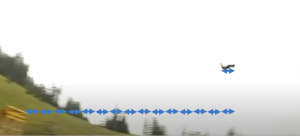45 Practice Makes Perfect V
Let’s get some practice with momentum problems. As a reminder:
- Every collision problem is a conservation of momentum problem
- Your drawing should include a before and after
- Use your drawing to set up the conservation of momentum equation.
Let’s try it now.
Exercise 45.1: Colliding Skaters
Two ice skaters collide on the ice rink. Skater A has a mass ![]() , and is skating north at a speed of 3 m/s. Skater B has a mass
, and is skating north at a speed of 3 m/s. Skater B has a mass ![]() , and is skating eastward at a speed of 4 m/s. After the skaters collide, Skater B is crumpled up and sliding at an angle
, and is skating eastward at a speed of 4 m/s. After the skaters collide, Skater B is crumpled up and sliding at an angle ![]() east of north at a speed of 3 m/s. How fast and in which direction is skater A moving after the collision?
east of north at a speed of 3 m/s. How fast and in which direction is skater A moving after the collision?
If you need to check your picture, you can do so here.
Exercise 45.2: Falling blocks
A block of mass ![]() sits at the edge of a frictionless table of height
sits at the edge of a frictionless table of height ![]() . A second block of mass
. A second block of mass ![]() slides towards the first block with speed
slides towards the first block with speed ![]() . The two blocks collide: they stick to each other, and fall off the table. How far from the edge of the table do the land?
. The two blocks collide: they stick to each other, and fall off the table. How far from the edge of the table do the land?
Try it on your own first. If you’re getting stuck, look at the hint. If you’re still stuck, trying doing a picture, compare it against mine, and then try going over the hint again.
Exercise 45.3: Low Earth orbit
The international space station orbits the Earth at some height ![]() . This is smaller than the radius of the Earth, so our “theory of gravity”
. This is smaller than the radius of the Earth, so our “theory of gravity” ![]() still holds. Find the orbital velocity of this ISS. The radius of the Earth is
still holds. Find the orbital velocity of this ISS. The radius of the Earth is ![]() .
.
If you get stuck with your picture, you can take a look at mine.
This is really quite fast, which you can see by looking at videos of how the Earth looks like from the ISS.
But to really get a sense of how fast that is, it makes more sense to ask: how would it look like if the ISS was flying just above our heads? If you’re curious, take a look.
Exercise 45.4: Water Slide
Some time back this video went viral.
You can use the video to time the jump, which takes about 2 seconds. For maximum distance, the ramp has to be at a 45-degree angle as the man leaves the ramp. Estimate how far the pool is from the ramp using this information. If you get stuck, can use the slider to reveal my picture.
As it turns out, the video is fake. You can check this by using a still from the video, e.g. the one below.

Assuming the man is 6 feet tall, or ![]() , we can see that while in the air, the man is already
, we can see that while in the air, the man is already ![]() body lengths away from the ramp, or
body lengths away from the ramp, or ![]() . However, from the timing of the video we found the pool had to be 19 m away from the ramp! Evidently the video is a fake.
. However, from the timing of the video we found the pool had to be 19 m away from the ramp! Evidently the video is a fake.
